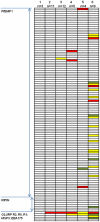Antibodies against PfEMP1, RIFIN, MSP3 and GLURP are acquired during controlled Plasmodium falciparum malaria infections in naïve volunteers
- PMID: 22174947
- PMCID: PMC3236238
- DOI: 10.1371/journal.pone.0029025
Antibodies against PfEMP1, RIFIN, MSP3 and GLURP are acquired during controlled Plasmodium falciparum malaria infections in naïve volunteers
Abstract
Antibodies to polymorphic antigens expressed during the parasites erythrocytic stages are important mediators of protective immunity against P. falciparum malaria. Therefore, polymorphic blood stage antigens like MSP3, EBA-175 and GLURP and variant surface antigens PfEMP1 and RIFIN are considered vaccine candidates. However, to what extent these antibodies to blood stage antigens are acquired during naive individuals' first infections has not been studied in depth. Using plasma samples collected from controlled experimental P. falciparum infections we show that antibodies against variant surface antigens, PfEMP1 and RIFIN as well as MSP3 and GLURP, are acquired during a single short low density P. falciparum infection in non-immune individuals including strain transcendent PfEMP1 immune responses. These data indicate that the immunogenicity of the variant surface antigens is similar to the less diverse merozoite antigens. The acquisition of a broad and strain transcendent repertoire of PfEMP1 antibodies may reflect a parasite strategy of expressing most or all PfEMP1 variants at liver release optimizing the likelihood of survival and establishment of chronic infections in the new host.
Conflict of interest statement
Figures






Similar articles
-
Natural antibody responses to Plasmodium falciparum MSP3 and GLURP(R0) antigens are associated with low parasite densities in malaria patients living in the Central Region of Ghana.Parasit Vectors. 2017 Aug 23;10(1):395. doi: 10.1186/s13071-017-2338-7. Parasit Vectors. 2017. PMID: 28835262 Free PMC article.
-
Low Levels of Human Antibodies to Gametocyte-Infected Erythrocytes Contrasts the PfEMP1-Dominant Response to Asexual Stages in P. falciparum Malaria.Front Immunol. 2019 Jan 14;9:3126. doi: 10.3389/fimmu.2018.03126. eCollection 2018. Front Immunol. 2019. PMID: 30692996 Free PMC article.
-
Humoral immune response to Plasmodium falciparum vaccine candidate GMZ2 and its components in populations naturally exposed to seasonal malaria in Ethiopia.Malar J. 2013 Feb 5;12:51. doi: 10.1186/1475-2875-12-51. Malar J. 2013. PMID: 23383869 Free PMC article.
-
Cerebral Plasmodium falciparum malaria: The role of PfEMP1 in its pathogenesis and immunity, and PfEMP1-based vaccines to prevent it.Immunol Rev. 2020 Jan;293(1):230-252. doi: 10.1111/imr.12807. Epub 2019 Sep 27. Immunol Rev. 2020. PMID: 31562653 Free PMC article. Review.
-
PfEMP1 - A Parasite Protein Family of Key Importance in Plasmodium falciparum Malaria Immunity and Pathogenesis.Adv Parasitol. 2015 Apr;88:51-84. doi: 10.1016/bs.apar.2015.02.004. Epub 2015 Mar 23. Adv Parasitol. 2015. PMID: 25911365 Review.
Cited by
-
Evidence for in vitro and in vivo expression of the conserved VAR3 (type 3) plasmodium falciparum erythrocyte membrane protein 1.Malar J. 2012 Apr 25;11:129. doi: 10.1186/1475-2875-11-129. Malar J. 2012. PMID: 22533832 Free PMC article.
-
Expression of a type B RIFIN in Plasmodium falciparum merozoites and gametes.Malar J. 2012 Dec 21;11:429. doi: 10.1186/1475-2875-11-429. Malar J. 2012. PMID: 23259643 Free PMC article.
-
Assessment of humoral immune responses to blood-stage malaria antigens following ChAd63-MVA immunization, controlled human malaria infection and natural exposure.PLoS One. 2014 Sep 25;9(9):e107903. doi: 10.1371/journal.pone.0107903. eCollection 2014. PLoS One. 2014. PMID: 25254500 Free PMC article. Clinical Trial.
-
Severe malaria is associated with parasite binding to endothelial protein C receptor.Nature. 2013 Jun 27;498(7455):502-5. doi: 10.1038/nature12216. Epub 2013 Jun 5. Nature. 2013. PMID: 23739325 Free PMC article.
-
Surface antigens of Plasmodium falciparum-infected erythrocytes as immune targets and malaria vaccine candidates.Cell Mol Life Sci. 2014 Oct;71(19):3633-57. doi: 10.1007/s00018-014-1614-3. Epub 2014 Apr 2. Cell Mol Life Sci. 2014. PMID: 24691798 Free PMC article. Review.
References
-
- Day KP, Marsh K. Naturally acquired immunity to Plasmodium falciparum. In: Ash C, Gallagher RB, eds. Immunol Today. 1991;12:A68–A71. - PubMed
-
- Gupta S, Snow RW, Donnelly CA, Marsh K, Newbold C. Immunity to noncerebral severe malaria is acquired after one or two infections. Nat Med. 1995;5:340–343. - PubMed
-
- Marsh K, Howard RJ. Antigens induced on erythrocytes by P. falciparum, expression of diverse and conserved determinants. Science. 1986;231:150–153. - PubMed
Publication types
MeSH terms
Substances
Grants and funding
LinkOut - more resources
Full Text Sources

